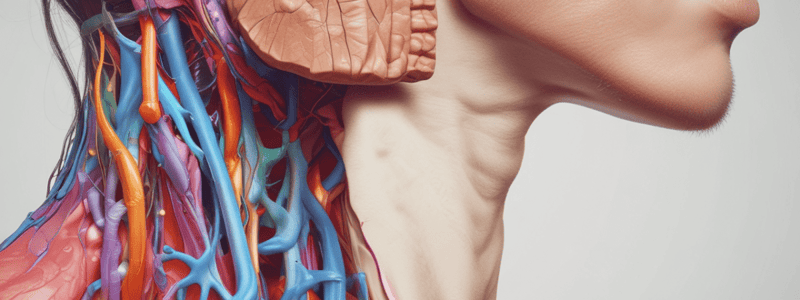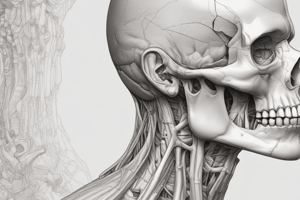Podcast
Questions and Answers
Which nerve passes through the muscular triangle of the neck?
Which nerve passes through the muscular triangle of the neck?
- Glossopharyngeal nerve
- Hypoglossal nerve (correct)
- Vagus nerve
- Spinal accessory nerve
Which of the following is NOT a structure found in the carotid triangle?
Which of the following is NOT a structure found in the carotid triangle?
- Common carotid artery and its branches
- Internal jugular vein and its tributaries
- Vagus nerve
- Submandibular gland (correct)
Which muscle forms the floor of the submandibular triangle?
Which muscle forms the floor of the submandibular triangle?
- Sternocleidomastoid
- Sternohyoid
- Mylohyoid (correct)
- Omohyoid
Which structure is found in the submental triangle?
Which structure is found in the submental triangle?
Which nerve originates from the posterior aspect of the medulla oblongata?
Which nerve originates from the posterior aspect of the medulla oblongata?
Which muscle group forms the floor of the carotid triangle?
Which muscle group forms the floor of the carotid triangle?
Which of the following muscles is responsible for flexing the head and bending the neck forward?
Which of the following muscles is responsible for flexing the head and bending the neck forward?
What is the action of the sternocleidomastoid muscle?
What is the action of the sternocleidomastoid muscle?
What is the condition called when there is a tortion of the neck?
What is the condition called when there is a tortion of the neck?
Which of the following nerves is responsible for the motor innervation of the sternocleidomastoid muscle?
Which of the following nerves is responsible for the motor innervation of the sternocleidomastoid muscle?
Which of the following structures is located in the lateral compartment of the neck, deep to the sternocleidomastoid muscle?
Which of the following structures is located in the lateral compartment of the neck, deep to the sternocleidomastoid muscle?
Which of the following muscle groups is responsible for depressing the hyoid bone or larynx after elevation?
Which of the following muscle groups is responsible for depressing the hyoid bone or larynx after elevation?
Which ganglion is the largest and situated in front of the transverse processes of C1~C3 vertebrae?
Which ganglion is the largest and situated in front of the transverse processes of C1~C3 vertebrae?
What structure hooks around the external carotid artery before entering the tongue?
What structure hooks around the external carotid artery before entering the tongue?
Which triangle in the neck contains the carotid artery?
Which triangle in the neck contains the carotid artery?
What is the smallest cervical ganglion and is located at the level of transverse processes of C6 vertebra?
What is the smallest cervical ganglion and is located at the level of transverse processes of C6 vertebra?
Which region of the neck contains the sternocleidomastoid muscle?
Which region of the neck contains the sternocleidomastoid muscle?
What does the superficial fascia in the neck consist of?
What does the superficial fascia in the neck consist of?
Which of the following structures is NOT contained within the carotid sheath?
Which of the following structures is NOT contained within the carotid sheath?
Which muscle forms the floor of the occipital triangle?
Which muscle forms the floor of the occipital triangle?
Which nerve emerges above the middle of the posterior border of the sternocleidomastoid muscle and crosses the occipital triangle?
Which nerve emerges above the middle of the posterior border of the sternocleidomastoid muscle and crosses the occipital triangle?
Which of the following structures is NOT contained within the supraclavicular triangle?
Which of the following structures is NOT contained within the supraclavicular triangle?
Which of the following muscles divides the lateral region of the neck into the occipital and supraclavicular triangles?
Which of the following muscles divides the lateral region of the neck into the occipital and supraclavicular triangles?
Which of the following structures is NOT contained within the prevertebral fascia?
Which of the following structures is NOT contained within the prevertebral fascia?
Which nerve innervates the cricothyroid muscle?
Which nerve innervates the cricothyroid muscle?
Which nerve passes deep to the posterior belly of the digastric muscle?
Which nerve passes deep to the posterior belly of the digastric muscle?
Which nerve provides motor and sensory innervation to the diaphragm?
Which nerve provides motor and sensory innervation to the diaphragm?
In which fascial plane does the vagus nerve descend in the neck?
In which fascial plane does the vagus nerve descend in the neck?
Which nerve forms the ansa cervicalis loop and supplies the infrahyoid muscles?
Which nerve forms the ansa cervicalis loop and supplies the infrahyoid muscles?
Which nerve innervates the laryngeal muscles, except for the cricothyroid?
Which nerve innervates the laryngeal muscles, except for the cricothyroid?
Flashcards
Ansa Cervicalis
Ansa Cervicalis
Loop of nerves from C1-C3 ventral rami that supplies the infrahyoid muscles.
Hypoglossal Nerve (CN XII)
Hypoglossal Nerve (CN XII)
Originates from the posterior medulla oblongata.
Carotid Triangle
Carotid Triangle
Contains the carotid artery, bounded by sternocleidomastoid, digastric, and omohyoid muscles.
Submental Triangle
Submental Triangle
Signup and view all the flashcards
Superficial Fascia (Neck)
Superficial Fascia (Neck)
Signup and view all the flashcards
Floor of the Carotid Triangle
Floor of the Carotid Triangle
Signup and view all the flashcards
Sternocleidomastoid Innervation
Sternocleidomastoid Innervation
Signup and view all the flashcards
Superior Cervical Ganglion
Superior Cervical Ganglion
Signup and view all the flashcards
Phrenic Nerve Function
Phrenic Nerve Function
Signup and view all the flashcards
Cricothyroid Muscle Innervation
Cricothyroid Muscle Innervation
Signup and view all the flashcards
Vagus Nerve (CN X) Location
Vagus Nerve (CN X) Location
Signup and view all the flashcards
Muscular Triangle Borders
Muscular Triangle Borders
Signup and view all the flashcards
Hypoglossal Nerve Path
Hypoglossal Nerve Path
Signup and view all the flashcards
Occipital Triangle Borders
Occipital Triangle Borders
Signup and view all the flashcards
Lateral Neck Contents
Lateral Neck Contents
Signup and view all the flashcards
Inferior Cervical Ganglion
Inferior Cervical Ganglion
Signup and view all the flashcards
Carotid Sheath Contents
Carotid Sheath Contents
Signup and view all the flashcards
Submandibular Triangle Floor
Submandibular Triangle Floor
Signup and view all the flashcards
Occipital Triangle Floor
Occipital Triangle Floor
Signup and view all the flashcards
Prevertebral Fascia Contents
Prevertebral Fascia Contents
Signup and view all the flashcards
Supraclavicular Triangle Contents
Supraclavicular Triangle Contents
Signup and view all the flashcards
Sternocleidomastoid Division
Sternocleidomastoid Division
Signup and view all the flashcards
External Laryngeal Nerve Path
External Laryngeal Nerve Path
Signup and view all the flashcards
Transverse Cervical Artery
Transverse Cervical Artery
Signup and view all the flashcards
Anterior Belly Omohyoid Function
Anterior Belly Omohyoid Function
Signup and view all the flashcards
Sternocleidomastoid Action
Sternocleidomastoid Action
Signup and view all the flashcards
Torticollis (Wryneck)
Torticollis (Wryneck)
Signup and view all the flashcards
Study Notes
Neck Anatomy
- The ansa cervicalis loop is formed by the C1-C3 ventral rami, and supplies the infrahyoid muscles.
- The hypoglossal nerve (CN XII) originates from the posterior aspect of the medulla oblongata.
- The carotid triangle contains the carotid artery, and is bounded by the sternocleidomastoid, posterior belly of digastric, and superior belly of omohyoid muscles.
- The submental triangle, located in the anterior triangle of the neck, contains the submental lymph nodes.
- The superficial fascia in the neck consists of platysma muscle and subcutaneous fat.
- The sternocleidomastoid muscle forms the floor of the carotid triangle, along with the scalene muscles.
- The sternocleidomastoid muscle is innervated by the spinal accessory nerve (CN XI).
- The superior cervical ganglion is the largest and is situated in front of the transverse processes of C1~C3 vertebrae.
- The phrenic nerve provides motor and sensory innervation to the diaphragm.
- The cricothyroid muscle is innervated by the external laryngeal nerve.
- The vagus nerve (CN X) descends in the neck within the carotid sheath.
- The muscular triangle of the neck is bounded by the sternocleidomastoid, omohyoid, and anterior belly of digastric muscles.
- The hypoglossal nerve (CN XII) hooks around the external carotid artery before entering the tongue.
- The occipital triangle is bounded by the sternocleidomastoid muscle, trapezius muscle, and superior belly of omohyoid muscle.
- The lateral compartment of the neck, deep to the sternocleidomastoid muscle, contains the spinal accessory nerve (CN XI), brachial plexus, and subclavian artery.
- The inferior cervical ganglion, located at the level of transverse processes of C6 vertebra, is the smallest cervical ganglion.
- The internal jugular vein, common carotid artery, and vagus nerve are contained within the carotid sheath.
- The floor of the submandibular triangle is formed by the mylohyoid muscle.
- The floor of the occipital triangle is formed by the splenius capitis and levator scapulae muscles.
- The prevertebral fascia contains the scalene muscles, cervical plexus, and phrenic nerve.
- The supraclavicular triangle contains the subclavian artery and vein, brachial plexus, and supraclavicular lymph nodes.
- The sternocleidomastoid muscle divides the lateral region of the neck into the occipital and supraclavicular triangles.
- The external laryngeal nerve passes deep to the posterior belly of the digastric muscle.
- The transverse cervical artery emerges above the middle of the posterior border of the sternocleidomastoid muscle and crosses the occipital triangle.
- The anterior belly of omohyoid is responsible for depressing the hyoid bone or larynx after elevation.
- The sternocleidomastoid muscle is responsible for flexing the head and bending the neck forward.
- Torticollis, also known as wryneck, is a condition caused by tortion of the neck.
Note: This information is for educational purposes only and should not be used for self-diagnosis or treatment. Consult with a healthcare professional for any medical concerns.
Studying That Suits You
Use AI to generate personalized quizzes and flashcards to suit your learning preferences.




